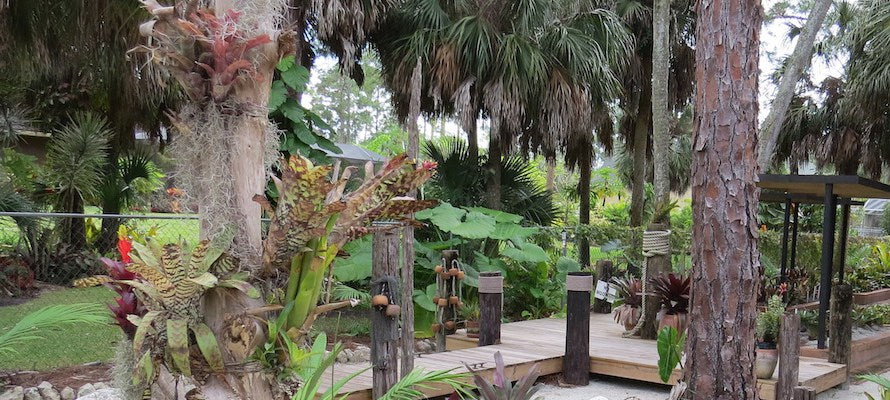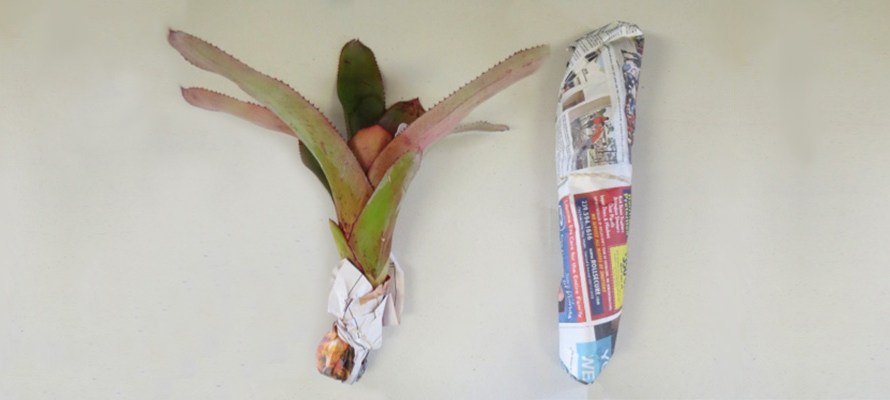Your Cart is Empty
Get Free Shipping on all orders $120 or more.

Bromeliads are a type of plant called epiphytes, which means that they draw moisture from the air and don’t need to be in soil to survive. While their roots can draw water and nutrients, they typically serve as a plant’s ‘anchor’, attaching and holding it place. Because of this, bromeliads will naturally fasten to and grow on trees and other debris in the wild.
Mounting bromeliads in your own landscape is pretty easy to do. All you need is the right surface and materials.
Bromeliads love to grow on rough, acidic surfaces, making trees, logs, and driftwood ideal to mount to. Large chunks of bark and cork are also good surfaces and can be used to hang plants on walls or from ceilings.
A basic idea is to use them on palms or other tall trees that have bare trunks. By mounting just a few bromeliads, they will eventually pup and cover a large part of the trunk. This makes it pretty easy to take new pups that stick out away from the trunk as well.
A growing trend in South Florida is to create bromeliad trees from driftwood for use as decoration in a lanai or around a swimming pool. They can also be used to cover unsightly surfaces.
Make sure whatever surface you are going to mount any bromeliad to is clean and clear of any other organic material. Scrub off any moss or fungi with a brush and spray the area with a hose. This helps to keep the plant safe from diseases and gives it a nice surface to grow into.
Any driftwood that was taken from the beach or ocean should be soaked in fresh water for at least a day to remove salt from the surface. If that isn’t possible, leave it in an area that gets hit with sprinklers or at least spray it with a hose several times to remove as much as possible. Bromeliads are much less likely to attach if there is too much salt and their roots could become dehydrated.
Select a bromeliad that is small enough to be supported by only its stem. If it is too large it will be top heavy and not attach properly. The roots will grow to support the weight as the plant itself grows later on.
If you are taking a new cutting to mount, make sure to get enough of the stem. This will give you more area to work with as you attach it.
Remove any dead leaves or flowers and then prune the roots back as much as possible. This allows the bromeliad to spend energy growing new roots rather.
Bromeliads will not be able to attach onto any surface if it is able to move. Even the slightest sway from a breeze can jar it and prevent the roots from attaching.
Because of this it is important to use the right material to attach a bromeliad to any surface. Here we list some common materials and why we like or dislike each one.
Twine – A natural jute twine is organic material that will rot away on its own. Not only is it better for the environment, but you don’t have to worry about the twine cutting into the plant or the stem. It is also great to use because it will swell and shrink with the stem when wet, providing a better hold.
The downside is that if it gets too wet too often, it may rot too quickly and break its hold before the plant has time to attach.
We use twine in our nursery anytime we are attaching to driftwood, pieces of bark, or anything that we can move indoors if needed.
If using twine to mount to trees outside, be sure to wait until a dry season to give your plants time to properly attach.
Electric Staples – Using round cable stables is our preferred method for attaching bromeliads to trees outdoors. They are great because you can find them in different sizes and the round shape conforms to the stem.
You only need to use two or three per plant and they will last long enough for the plant to attach itself. They are also very hard to see from any distance.
The only downside is that they can damage the plant if you use too small of a staple and it cuts into the stem. They do rust away naturally and the rust doesn’t seem to harm the plant at all.
Silicon Glue – A silicon glue can be used to secure a plant tightly without the risk of damaging it. We have successfully attached many plants using this method.
We stopped however because the roots are not able to grow through the glue and have to grow around it. This can create problems and lengthen the time it takes to attach. The glue can also be messy and unsightly.
Never use hot glue as it will damage the plant and could possibly kill it.
Fishing Line – Fishing line is commonly used as a way to mount bromeliads, but we do not use or recommend it.
Although it is very strong and hides well, it will not disintegrate and unless removed, will last for life. This can create problems as the plants grow and spread, potentially cutting into the stem and preventing other pups from attaching.
Fishing line is also not elastic, so it will not shrink like twine does with the stem when it gets dehydrated. Just this little movement can lengthen the time to attach by months.
Non Copper Wire – A non copper wire is another material we have seen used to wrap around a tree or piece of wood. Although it is strong and will eventually disintegrate, it can be difficult to get tight enough without cutting into the stem.
Like fishing line it is also not elastic, and can cause delays as the stem shrinks and swells.
Whatever material you decide to use to mount your bromeliads, always remember to only attach it by the stem. Do not use glue or staples on the leaves, as it will not help in securing the plant. The leaf will just detach itself after being damaged and cause the plant to move or fall.
If it can’t be secured by the stem alone, it is likely too large and top heavy to successfully attach You can try to lightly wrap some twine around the top of the plant until it has attached. It is likely however that it will still cause the roots to eventually tear away once removed.
It can take anywhere from 1-6 months to attach depending on the bromeliad and the conditions. Using a liquid fertilizer ½ the recommended strength monthly and keeping it free from debris can help the roots grow more quickly and stronger.
Be sure to water often but lightly as to not move or jar the plant. A spray bottle works well for this.
To better hide the material used for mounting, you can drill holes through driftwood or bark so it does not wrap all the way around. You can also use spanish moss or sphagnum moss tucked under the twine to hide it completely.

When a bromeliad is ordered on-line, it will either be taken as an offset from a mother plant, or it will be taken from a pot. Either way, it is possible that it has already started to grow roots.

Although mosquitoes are not a pest that can harm your bromeliads, they can become very annoying to everyone around them. Mosquitoes are currently a topic of conversation as common sense and the facts often give way to rumor and sensationalism.

Humidity is a key requirement for healthy Bromeliads. What Is humidity? At it’s simplest, it’s just a measure of how much moisture is in the air relative to the maximum amount of moisture the air can hold.